I Asked ChatGPT to Write Resumes, Including Mine. Here’s What Happened. was originally published on Forage.
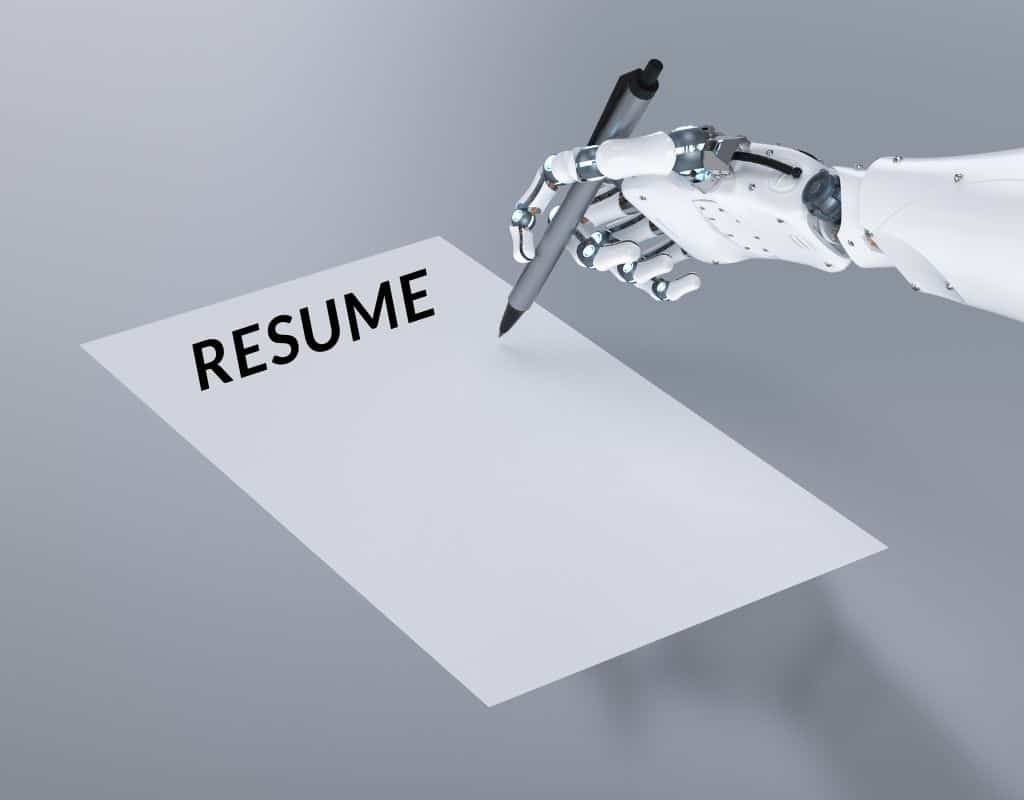
Whether you think artificial intelligence (AI) is coming for your job or not, it’s here to stay. And the buzziest of all AI is ChatGPT. Though it’s capable of many things, should ChatGPT write your resume?
Consider ChatGPT’s compelling results. A recruiter put ChatGPT-generated documents to the test and found that they landed interviews. And one survey found that out of 1,000 job seekers, 46% say they are using ChatGPT to write their cover letters and resumes. Of those, 78% say they got an interview and 59% claim they were hired. In addition, nearly 70% of job seekers report a higher response rate from companies when they use ChatGPT to help them apply.
But does that mean ChatGPT is the right choice for you and your resume? Maybe. We ran a number of experiments and put ChatGPT to the test writing and rewriting resumes.
- What Is ChatGPT and What Does It Do?
- Using ChatGPT to Write a Resume
- Using the Paid Version of ChatGPT to Write Your Resume
- Using ChatGPT to Write a Real Resume
- Should ChatGPT Write Your Resume?
What Is ChatGPT and What Does It Do?
ChatGPT is built on natural language processing (NLP). In short, the bot is trained to understand text the way humans do. It “learns” through the use of data sets, or large amounts of information that “teach” the AI how to recognize patterns. From that training, the AI learns how to craft a response that seems relatively life-like and, in most cases, reasonable.
>>MORE: What Is Machine Learning?
Using ChatGPT to Write a Resume
Using ChatGPT consists of two parts: the prompt and the output. The prompt is where you ask ChatGPT your question and the output is the response. For our first round of testing, we gave ChatGPT some basic prompts: Write a resume for X. Here’s what we got.
An entry-level software programmer:
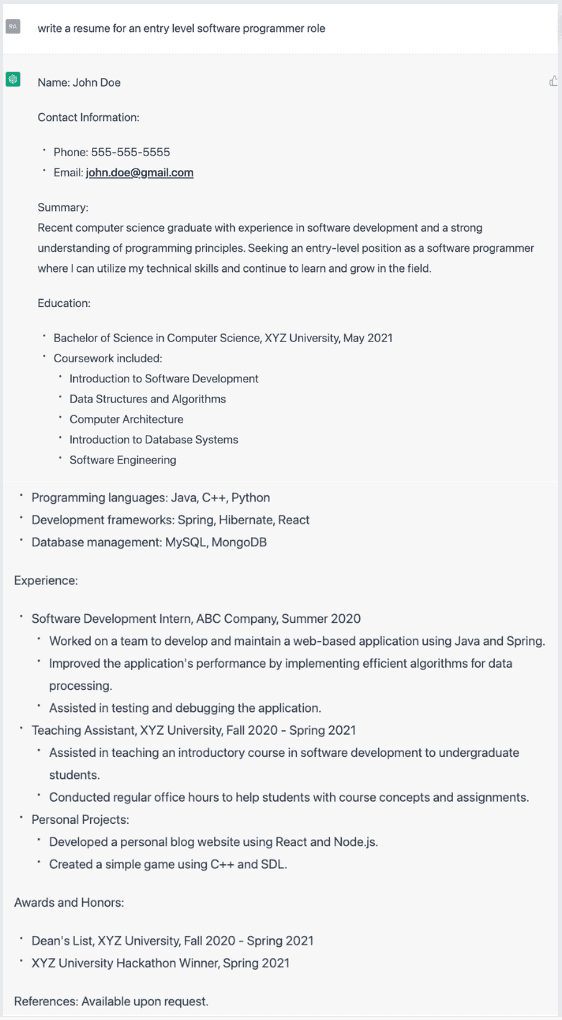
Entry-level financial analyst:
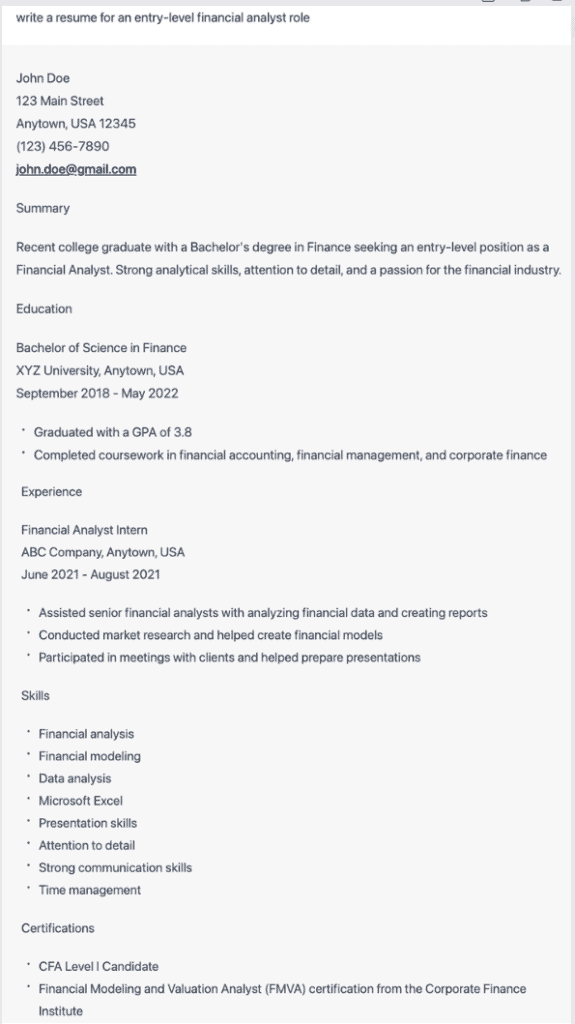
The deckhand on a pirate ship:
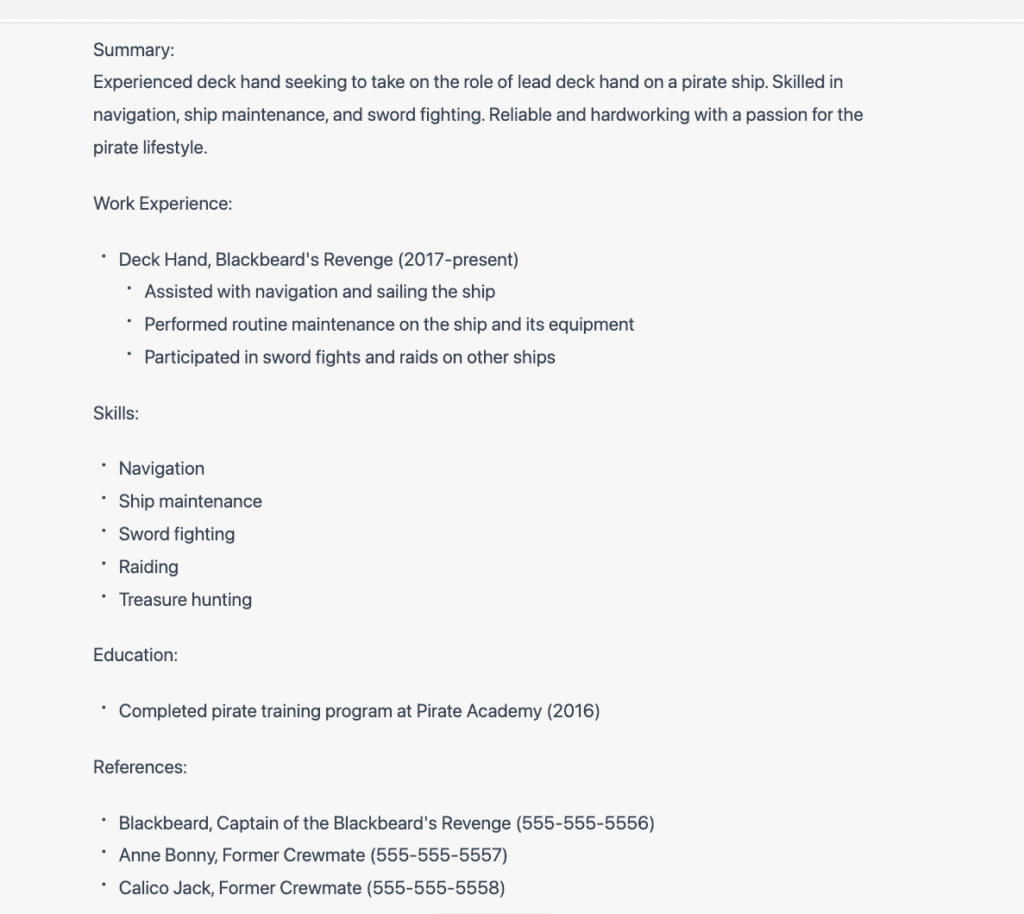
Overall, these resumes are just OK. The main problem is that they’re generally nothing more than a summary of the job seeker’s duties. None of these resumes describe how the candidate used their skills and abilities or what the positive result was.
>>MORE: How to Write a Resume
For example, the software programmer’s resume says, “Improved the application’s performance by implementing efficient algorithms for data processing.” That’s an excellent thing to point out to a potential employer but it doesn’t explain how much the performance improved.
It’s the same on the pirate deckhand’s resume. It lists specific skills, like sword fighting, raiding, and treasure hunting, but nowhere does it say how the deckhand used those skills or why it matters to the captain or the rest of the crew.
These resumes also include things that are no longer necessary. The software resume includes the phrase “references available upon request,” the financial analyst resume includes a street address, and the deckhand resume is all in on the references, with names and phone numbers.

Resume Writing Masterclass
Write a resume without AI. Learn how to present your skills and experiences to employers with maximum impact.
Avg. Time:
5-6 Hours
Skills you’ll build:
Resume writing, professional branding, demonstrating outcomes
There’s nothing wrong with including them, but they take up valuable real estate on a short document. You’re better off including information about your abilities and outcomes than mentioning you have professional references ready to go.
But the biggest problem with these resumes is that they are entirely made-up, or hallucinations. ChatGPT invented work histories, job duties, degrees, certifications, and references!
The Problem With Prompts
All of these resumes fall short, but we’re willing to take the blame for that. We gave ChatGPT very broad prompts, which is likely what led to the hallucinations. Chat GPT was forced to fill in the gaps and predict what a resume for a financial analyst or deckhand would look like. And because ChatGPT had to make broad guesses, it couldn’t get any more specific than “improved performance.”
This is a common experience. Bonnie Dilber, recruiting manager at Zapier says, “When I initially asked ChatGPT to write resume bullet points, it did not include any metrics.”
Using the Paid Version of ChatGPT to Write Your Resume
When ChatGPT-4 came out, we wondered how much the bot had improved. Would it produce better resumes that are worth the $20 a month investment?
GPT-4 Resume Writing Experiment #1
Our first ask was for a resume for an entry-level financial analyst. Here’s what GPT-4 produced:
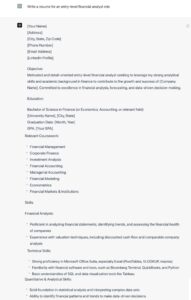
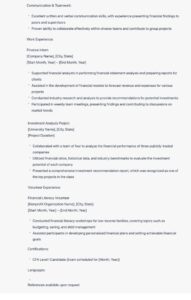
This is a very long resume full of hallucinations. It took approximately five screenshots to capture everything, compared to two screenshots from the earlier version. When we pasted the output in a Google doc and formatted it (Arial font, size 11), it was just over three pages long. And it still includes things you don’t need on a resume, like a full address, “references available upon request,” and an objective.
>>MORE: How Long Should a Resume Be in 2022?
GPT-4 placed the education section ahead of the experience section. While this isn’t wrong, you generally only put education ahead of experience on a curriculum vitae (CV). Recruiters are usually more interested in your skills and abilities than where you went to school.
The skills section on this resume is broken into two categories, like what you might do on a functional resume. However, this takes up a lot of space. The section is “Skills,” and that’s subdivided into “Technical,” “Quantitative and Analytical Skills, and “Communication and Teamwork.” While separating your hard and soft skills might be helpful to the reader, you’re probably better off condensing this section into something smaller or including it as part of the professional summary.
>>MORE: 7 Types of Resumes: Which Is Right for You?
The skills section also doesn’t include quantifiable results. Mentioning strong Microsoft Excel skills (like PivotTables) is a smart idea. But you need to explain how you use your Excel skills at work or in school. And it’s better to link your skills to a specific job or educational experience (like a project) whenever possible. This helps the reader understand where you learned the skills. Did you learn them on the job or teach yourself?
>>MORE: Learn Microsoft Excel skills. Enroll in Goldman Sachs’ Excel Skills for Business Virtual Job Simulation.
GPT-4 Resume Writing Experiment #2
Of course, we couldn’t conduct our experiment without asking for a pirate deckhand resume:
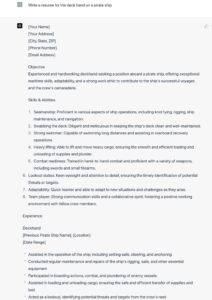
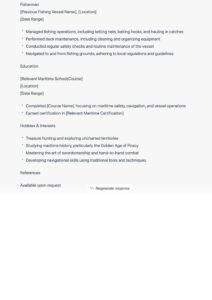
While this resume is shorter, it contains many of the above concerns. However, GPT-4 does a better job explaining how the deckhand uses their skills for the good of the entire crew compared to the earlier version.
Take a look at the “Skills and Abilities” section. Though the skills and abilities are numbered, which you wouldn’t normally do on a resume, check out number six: Lookout duties. This is neither a skill nor an ability. It’s a job duty and in the wrong section (or the section is mislabeled) but the resume explains how the deckhand uses their skills and abilities to help the team:
Lookout duties: Keen eyesight and attention to detail, ensuring the timely identification of potential threats or targets.
While a bit clunky, this isn’t bad. It’s a decent example of quantifying your abilities into measurable results. A better version might be:
Keen eyesight and attention to detail: Ensure timely identification of potential threats or targets while on lookout duty.
The rewrite emphasizes your skills first, how you used your skills to help the team, and then mentions the duties of the role.
Using ChatGPT to Write a Real Resume
Asking GPT-4 to whip up a resume is fun. But, none of our experiments are for real people, which explains the hallucinations.
So, what happens when your input consists of real information for a real person? Can you feed your resume into ChatGPT and improve it?
I put my resume to the test and asked ChatGPT to make it better.
How ChatGPT Rewrote My Resume
I input parts of my resume to ChatGPT and asked it to improve the document.
The first thing I noticed is that ChatGPT wrote the entire resume in past tense. That’s fine for my previous positions but not my current one. I’m doing all those things right now!
Outside of that grammatical error, though, the rewrites were just OK.
Take, for example, this bullet point. I have, “Produce content according to calendar due dates.” That’s not fantastic (and I could do better), but it is accurate. ChatGPT changed it to “Managed content production calendar.” There’s no denying that’s an improvement, which is exactly what I asked ChatGPT to do. But it’s not true, not even a little, and I would not be comfortable submitting that bullet point as part of a job application.
Improving ChatGPT-4’s Improvements
But, once again, the fault lies with me. I gave ChatGPT a very general prompt. So, I tried drilling down my inputs to see if I could improve ChatGPT’s improvements.
I asked ChatGPT to rewrite this bullet point. I picked it because it’s short and doesn’t include any metrics or explain the importance of locating and interviewing subject matter experts:
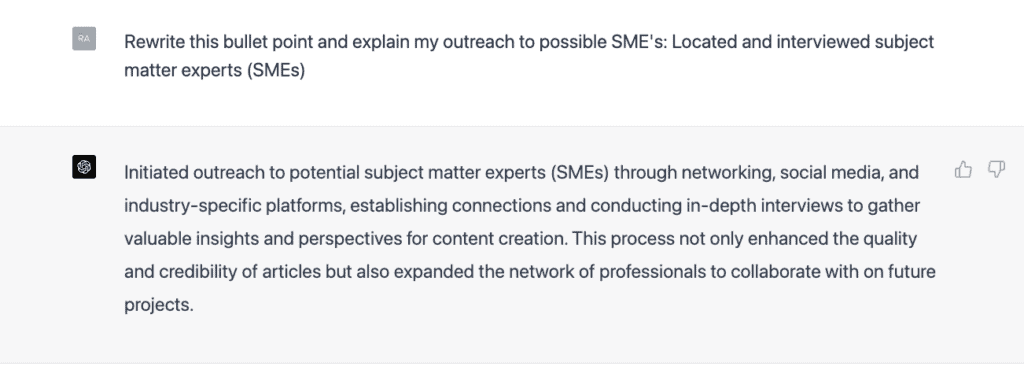
This is pretty good. It’s a little over the top but is a fair assessment of the process. It does a decent job explaining how I reach out to experts and why I interview them for articles. My only complaint is it’s too long for a bullet point and would need some paring down before landing on my resume.
After some experimentation, I decided that part of the problem with relying on ChatGPT to write my resume is that it seems to make assumptions based on the input. For example, I asked it to write a bullet point about my SEO writing:
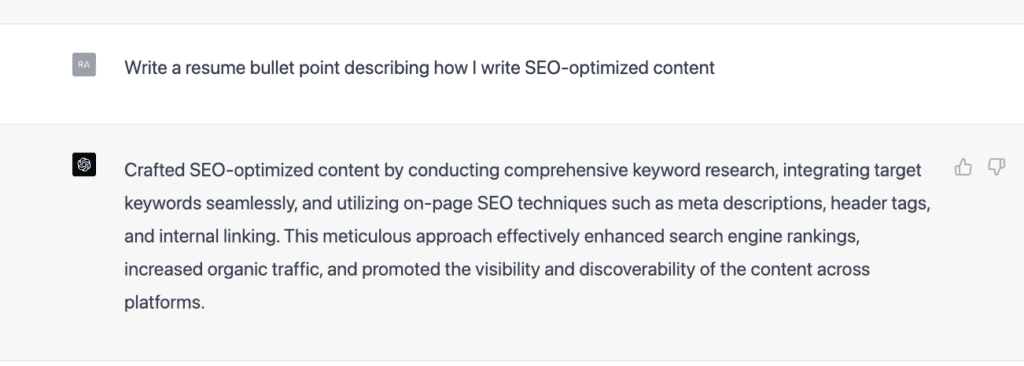
This is both accurate and inaccurate. I do integrate the target keyword seamlessly and use internal linking. However, ChatGPT’s rewrite also describes how I use on-page SEO techniques like meta statements and header tags, and how I conduct “comprehensive keyword research.”
While these activities are part of effective SEO writing, in that particular role, I didn’t do any of that. I think ChatGPT was making assumptions based on my inclusion of “SEO.” So, I asked it to try again, only this time, I specified what aspects of SEO it should ignore:
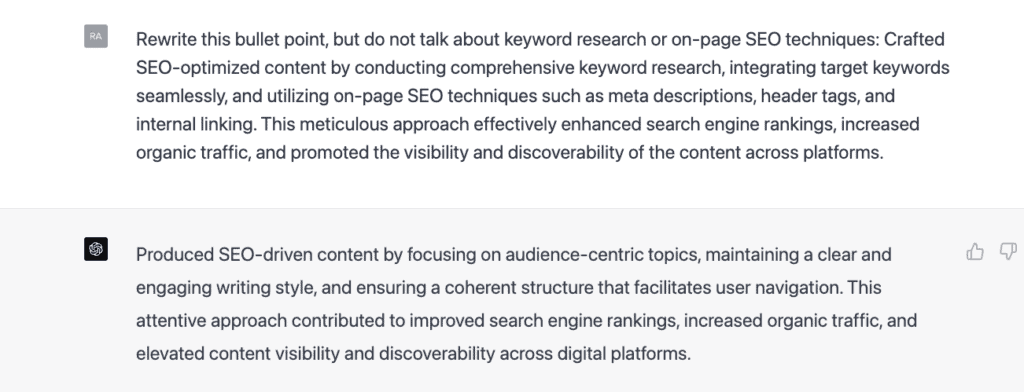
This is a little better. It removes the hallucinations of what I was doing in that role. However, I’d probably delete the second part of the bullet. I did not have access to the metrics and cannot confirm if my SEO writing did improve rankings, increased traffic, or elevated content visibility and discoverability (but I hope it did!).
Should ChatGPT Write Your Resume?
In general, these results were decent but not spectacular. It took several tries to get an output that didn’t overstate or inflate what I was doing and even more tries to ensure ChatGPT didn’t include things I didn’t do at all. Given how much time I spent redirecting ChatGPT, I might have been better off using the initial output as a draft and rewriting my resume without AI assistance from there.
Dilber had a similar experience. After ChatGPT gave her the initial resume bullet points, she asked it to “rewrite these bullet points with examples of results and metrics,” and got a better response. But she also cautions that even with a “better response” you should take the time to review and rewrite ChatGPT’s output.
“You’ll always want to edit for accuracy to make sure you aren’t misrepresenting your work and to make sure it sounds like you. As an applicant, you want to stand out from the crowd. A lot of people are using ChatGPT so if you simply submit what it creates, it’s likely your resume and cover letter will be the same as everyone else,” she says.
So, should you even bother using ChatGPT to write your resume?
“Job seekers should use ChatGPT as a starting point to break the whitespace of a blank page and not as a way to create a finished resume,” advises Miles Jennings, founder of Recruiter.com. “For example, if you’re trying to be a graphic designer, ask it to write an amazing resume for an early career graphic designer. But then you take it from there. Put the output in a Google doc and edit it as much as possible.”
So, if you’re having trouble getting started or need help rewriting a messy bullet point, ChatGPT can be an excellent writing prompt, outline generator, and general guide to help you write your resume. But you shouldn’t rely on the output. ChatGPT hallucinates — sometimes despite your best efforts. And if you include these hallucinations on your resume, you may find yourself in an interview getting asked about skills and abilities you don’t actually possess.
Learn more ways to leverage ChatGPT in your job search:
- We Asked ChatGPT to Cover Letters. Here’s What It Got Right (and Wrong)
- Should You Use ChatGPT for Interview Advice?
- How to Use ChatGPT in Your Job Search
- Can You Use ChatGPT to Prepare for Technical Interviews?
Image Credit: Canva
The post I Asked ChatGPT to Write Resumes, Including Mine. Here’s What Happened. appeared first on Forage.

